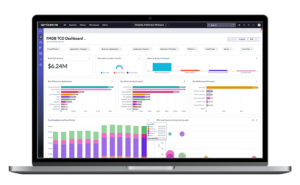There are three core phases necessary to launch a new showback or chargeback and deliver it as a bill of IT.
First, the organization must consider the tactical and strategic differences between showback and chargeback, then decide which to pursue (See this post for a deeper explanation of showback vs. chargeback). Next, every service to be included in the bill of IT needs to be defined, cataloged, and accurately costed – a process you can learn more about in our eBook, A Practitioner’s Guide to Cost Modeling. Lastly, the organization must evaluate its goals and needs to select a bill of IT execution strategy.
The bill of IT execution strategy governs two key processes:
- How actuals flow through the cost model and out to the bill of IT
- How monthly variance is managed and allocated across consumers
Although there’s room for customization, most execution strategies fall into three major categories:
- Percentage of Use
- Fixed Rate – Option A (with Under/Over)
- Fixed Rate – Option B (without Under/Over)
Let’s dive into each strategy to understand its mechanics, key benefits, and potential drawbacks.
*Note: If your organization is not pursuing a chargeback in the foreseeable future – or if there’s no need for the bill of IT to tie back to the GL on a regular basis – then the inclusion of over/under or true-up processes is optional.
Percentage of Use
The first, most basic way to structure the bill of IT is by allocating to consumers based on their individual responsibility for total service costs. The two main advantages of this strategy are its simplicity and the fact that it results in 100% of incurred costs being allocated monthly.
It works like this:
- Run monthly actuals through the cost model to find:
- Current effective rates.
- Total cost of each service.
- Calculate each consumer’s usage as a percentage of the total service cost.
- Charge or report on that percentage and show the full breakdown in each consumer’s bill of IT.
For example, let’s say there’s one service with three consumers in a given month. Using cost model actuals and consumption data, we find the first consumer holds responsibility for 25% of the monthly total, the second 15%, and the third 60%.
In the bill of IT, each consumer will see actual consumption, the total cost for the service in question, and the percentage of that total tied to usage (what would be billed in a chargeback scenario).
Key Benefits
- Low complexity – compared to other strategies, Percentage of Use has the fewest components, which means less confusion and opportunity for error.
- Ease of implementation and maintainability – again, due to its simplicity, this strategy requires the least effort to launch and maintain.
- 100% monthly allocation without under/over – for organizations who must allocate and/or recover the entirety of IT service costs each month – tying billing reports to the GL without needing a true-up or monthly over/under recovery – Percentage of Use is the most straightforward strategy to achieve that goal.
Potential Drawbacks
- Not predictable – considerable fluctuations can occur in response to changes in demand or one-time expenses and credits.
- Raises questions of fairness – depending on fixed vs. variable cost components for a given service, when consumers stop or dramatically reduce usage, it can cause other consumers’ bills to spike – regardless of their usage staying the same.
Fixed Rate – Option A (with Under/Over)
For organizations wishing to bill on actual consumption more accurately than Percentage of Use will allow, while still allocating 100% of service costs monthly, a Fixed Rate with Under/Over strategy is the ideal choice.
Here’s a step-by-step summary of the process:
- Create fixed annual rates by running the full year budget through the cost model.
- Run actuals through the cost model monthly to obtain true cost of service for the month.
- Determine each consumer’s service cost obligation using monthly usage data and fixed annual rates.
- Calculate the under/over recovery amount (Actual monthly cost of service – (Fixed Annual Rate * Actual Service Consumption))
- Populate the bill of IT and include a separate line item charge or credit for the under/over (This can be spread across consumers using a basic percentage, usage by service, or any other agreed upon metric).
Key Benefits
- Offers the fairest way to achieve full monthly cost recovery – out of all three strategies outlined in this eBook, only the first two result in 100% of costs being allocated out each month. Between those two, Fixed Rate with Under/Over bills on actual usage to minimize the impact of expense seasonality, making it the fairest choice if 100% monthly allocation is required.
- Ensures the bill of IT matches actual expenditures
– by managing variance between plan and actuals each month, this strategy produces a bill of IT that always ties back to the GL.
Potential Drawbacks
- Still lacks consistency – although this strategy produces a somewhat steadier cost of service than Percentage of Use, it’s still inherently unpredictable due to the variance between annual and effective rates charged monthly (the under/over).
- Requires more effort to launch and maintain – out of all three strategies, this one tends to require the most time and effort. It also has more moving parts, which can make integration with existing systems difficult.
- Potential conflict on under/over allocation – collaboration across the business is required to establish a reasonable method for allocating the monthly over/under across consumers, but reaching a final agreement can be challenging.
Fixed Rate – Option B (without Under/Over)
In situations where 100% of costs don’t need to be allocated to consumers monthly – maybe because the bill of IT is being delivered as a showback only, or in an attempt to reduce the administrative burden of a chargeback – organizations often utilize the same core Fixed Rate strategy but without an under/over charge in the bill of IT.
Instead of using a monthly under/over like Option A, Option B monitors monthly effective rates, adjusts them when needed, and uses periodical true-ups to reconciled back to the GL.
In other words, Option A and Option B are essentially two sides of the same methodological coin for Fixed Rate. The only difference is how each option manages variance between plan and actuals.
Neither option is right or wrong. But there are some important trade-offs between the two.
Keeping in mind what we’ve already discussed about Option A, let’s investigate the benefits and drawbacks of Option B.
Key Benefits
- Provides the most consistent and predictable bills – by excluding the over/under and keeping costs tied directly to monthly usage, consumers can more easily anticipate charges.
- Prevents confusion and dispute – consumers pay for only what they use, nothing more and nothing less, which encourages prompt and complete payment.
Potential Drawbacks
- Produces a bill of IT that doesn’t match actual expenditures – since variances between plan and actuals aren’t addressed monthly, the bill of IT won’t reflect true costs by tying back to the GL.
- Needs periodic monitoring and possible rate adjustments – chargeback models operating without a monthly over/under will require users to monitor rates on a monthly or quarterly basis. If the fixed rate is materially off from the actual rate, your organization may need to introduce some mid-year rate adjustments. However, this is a non-issue for showback models; since no money is changing hands, a true-up would just be an accounting entry.
Building a Showback or Chargeback Model from Scratch
For additional guidance on showback or chargeback, download a copy of our new eBook: “How to Produce an Effective Bill of IT Using Showback or Chargeback.”
Inside, we detail everything you need to know about launching a new showback or chargeback — from start to finish. You’ll also learn the important strategic differences between the two, and what those differences mean for the bill of IT.





